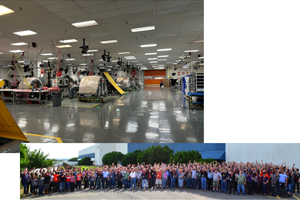CH-53K helicopter passes initial operational testing
Sikorsky's composites-intensive CH-53K King Stallion heavy-lift helicopter completed the week-long operational assessment on Oct. 21.
Lockheed Martin (Bethesda, MD) says that the CH-53K King Stallion successfully completed initial operational testing by the U.S. Marine Corps on Oct. 21 to verify the key capabilities of the heavy lift helicopter. The week-long operational assessment by Marine Corps pilots, aircrew and maintainers marked an important step in support of a Low Rate Initial Production (LRIP) Milestone C decision early next year.
“This successful operational assessment by the Marine Corps is a clear sign of the maturity and the robust capability of the King Stallion,” said Dr. Michael Torok, Sikorsky Vice President CH-53K Programs. “This was a key requirement in support of the upcoming Milestone C decision, and its success is another important step in our transition from development into production.”
The U.S. Marine Corps’ initial operational testing included external lift scenarios of 27,000 lb in hover and a 12,000 lb. 110 nautical mile radius mission. Ground events included embarkation / debarkation of combat equipped troops, internal and external cargo rigging, tactical bulk fuel delivery system (TBFDS) operation and medevac litter configuration.
Overall, post evaluation interviews of aircrew, ground crew and flight surgeons revealed a high regard for the operational capability demonstrated by the King Stallion. This customer assessment is a pre-requisite to Milestone C and is intended to minimize risk to successfully pass the U.S. Marine Corps operational evaluation (OPEVAL) phase for a future full rate production decision.
“OT-B1 (Operational Test) is a critical milestone for the program because this is the first time an operational test has been done utilizing an ’All Marine’ crew,” says Col. Hank Vanderborght, U.S. Marine Corps program manager for Naval Air Systems Command’s Heavy Lift Helicopters Program. “All test objectives were met, and the aircraft performed very well. This further increases our confidence in the design, and is another key step to successfully fielding the CH-53K."
The operational testing was based out of the Sikorsky Development Flight Center (DFC) in West Palm Beach, Fla., where CH-53K development flight test is continuing to make excellent progress now with all four Engineering Development Model (EDM) aircraft in flight status.
The King Stallion will carry three times the external payload of the predecessor CH-53E equating to a 27,000-pound external load over 110 nautical miles under “high hot” ambient conditions. The CH-53K helicopter provides unmatched heavy lift capability with reduced logistics footprint and reduced support costs over its entire life cycle. CH-53K pilots can execute heavy lift missions more effectively and safely in day/night and all weather with the King Stallion’s modern glass cockpit. Fly-by-wire flight controls facilitate reduced pilot workload for all heavy lift missions including external loads, maritime operations, and operation in degraded visual environments. With more than triple the payload capability of the predecessor CH-53E, the King Stallion’s increased capability can take the form of a variety of relevant payloads ranging from an internally loaded High Mobility Multipurpose Wheeled Vehicle (HMMWV) to up to three independent external loads at once which provides “outstanding mission flexibility and system efficiency.” A locking, U.S. Air Force pallet compatible cargo rail system reduces both effort and time to load and unload palletized cargo.
The U.S. Department of Defense's Program of Record remains at 200 CH-53K aircraft. The first four of the 200 “Program of Record” aircraft are scheduled for delivery next year to the U.S. Marine Corps, with another two aircraft to follow. Two additional aircraft are under long lead procurement for parts and materials, with deliveries scheduled to start in 2020 The Marine Corps intends to stand up eight active duty squadrons, one training squadron, and one reserve squadron to support operational requirements.
Related Content
Altair, NIAR sign MOU to build aerospace innovation space
Collaboration will expand digital twin adoption, empower aerospace startups and speed up product development and certification processes.
Read MoreFACC Academy begins training, onboarding operations
FACC’s newly launched training platform will address skilled aerospace worker shortages head on, offering more than 250 specialized training courses for its entire workforce.
Read MoreSAMPE 2025: Innovation, circularity and connection drive composites forward
Collaboration, workforce development and an ongoing focus on scalability and sustainability took center stage at SAMPE 2025 in Indianapolis.
Read MoreReducing accidental separator inclusion in prepreg layup
ST Engineering MRAS discusses the importance of addressing human factors to reduce separator inclusion in bonded structures.
Read MoreRead Next
Ceramic matrix composites: Faster, cheaper, higher temperature
New players proliferate, increasing CMC materials and manufacturing capacity, novel processes and automation to meet demand for higher part volumes and performance.
Read MoreUltrasonic welding for in-space manufacturing of CFRTP
Agile Ultrasonics and NASA trial robotic-compatible carbon fiber-reinforced thermoplastic ultrasonic welding technology for space structures.
Read MoreScaling up, optimizing the flax fiber composite camper
Greenlander’s Sherpa RV cab, which is largely constructed from flax fiber/bio-epoxy sandwich panels, nears commercial production readiness and next-generation scale-up.
Read More











